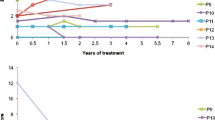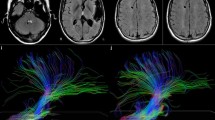Abstract
Cerebrotendinous xanthomatosis (CTX) is a metabolic disease characterized by systemic signs and neurological impairment, which can be prevented if chenodeoxycholic acid (CDCA) treatment is started early. Despite brain MRI represents an essential diagnostic tool, the spectrum of findings is worth to be reappraised, and follow-up data are needed. We performed clinical evaluation and brain MRI in 38 CTX patients. Sixteen of them who were untreated at baseline examination underwent clinical and MRI follow-up after long-term treatment with CDCA. Brain MRI abnormalities included cortical and cerebellar atrophy, and T2W/FLAIR hyperintensity involving subcortical, periventricular, and cerebellar white matter, the brainstem and the dentate nuclei. Regarding the dentate nuclei, we also observed T1W/FLAIR hypointensity consistent with cerebellar vacuolation and T1W/FLAIR/SW hypointense alterations compatibly with calcification in a subgroup of patients. Long-term follow-up showed that clinical and neuroradiological stability or progression were almost invariably associated. In patients with cerebellar vacuolation at baseline, a worsening over time was observed, while subjects lacking vacuoles were clinically and neuroradiologically stable at follow-up. The brains of CTX patients very often show both supratentorial and infratentorial abnormalities at MRI, the latter being related to clinical disability and including a wide spectrum of dentate nuclei alterations. The presence of cerebellar vacuolation may be regarded as a useful biomarker of disease progression and unsatisfactory response to therapy. On the other hand, the absence of dentate nuclei signal alteration should be considered an indicator of better prognosis.




Similar content being viewed by others
References
Cali JJ, Russell DW (1991) Characterization of human sterol 27-hydroxylase. A mitochondrial cytochrome P-450 that catalyzes multiple oxidation reaction in bile acid biosynthesis. J Biol Chem 266:7774–7778
Mignarri A, Magni A, Del Puppo M et al (2016) Evaluation of cholesterol metabolism in cerebrotendinous xanthomatosis. J Inherit Metab Dis 39:75–83
Mignarri A, Gallus GN, Dotti MT, Federico A (2014) A suspicion index for early diagnosis and treatment of cerebrotendinous xanthomatosis. J Inherit Metab Dis 37:421–429
Panzenboeck U, Andersson U, Hansson M, Sattler W, Meaney S, Björkhem I (2007) On the mechanism of cerebral accumulation of cholestanol in patients with cerebrotendinous xanthomatosis. J Lipid Res 48:1167–1174
Inoue K, Kubota S, Seyama Y (1999) Cholestanol induces apoptosis of cerebellar neuronal cells. Biochem Biophys Res Commun 256:198–203
Soffer D, Benharroch D, Berginer V (1995) The neuropathology of cerebrotendinous xanthomatosis revisited: a case report and review of the literature. Acta Neuropathol 90:213–220
Barkhof F, Verrips A, Wesseling P et al (2000) Cerebrotendinous xanthomatosis: the spectrum of imaging findings and the correlation with neuropathologic findings. Radiology 217:869–876
Pilo de la Fuente B, Ruiz I, Lopez de Munain A, Jimenez-Escrig A (2008) Cerebrotendinous xanthomatosis: neuropathological findings. J Neurol 255:839–842
Wallon D, Guyant-Maréchal L, Laquerrière A et al (2010) Clinical imaging and neuropathological correlations in an unusual case of cerebrotendinous xanthomatosis. Clin Neuropathol 29:361–364
Yahalom G, Tsabari R, Molshatzki N, Ephraty L, Cohen H, Hassin-Baer S (2013) Neurological outcome in cerebrotendinous xanthomatosis treated with chenodeoxycholic acid: early versus late diagnosis. Clin Neuropharmacol 36:78–83
Berginer VM, Salen G, Shefer S (1984) Long-term treatment of cerebrotendinous xanthomatosis with chenodeoxycholic acid. N Engl J Med 311:1649–1652
Pilo de la Fuente B, Jimenez-Escrig A, Lorenzo JR et al (2011) Cerebrotendinous xanthomatosis in Spain: clinical, prognostic, and genetic survey. Eur J Neurol 18:1203–1211
Rubio-Agusti I, Kojovic M, Edwards MJ et al (2012) Atypical parkinsonism and cerebrotendinous xanthomatosis: report of a family with corticobasal syndrome and a literature review. Mov Disord 27:1769–1774
Pedley TA, Emerson RG, Warner CL, Rowland LP, Salen G (1985) Treatment of cerebrotendinous xanthomatosis with chenodeoxycholic acid. Ann Neurol 18:517–518
Swanson PD, Cromwell LD (1986) Magnetic resonance imaging in cerebrotendinous xanthomatosis. Neurology 36:124–126
Bencze KS, Vande Polder DR, Prockop LD (1990) Magnetic resonance imaging of the brain and spinal cord in cerebrotendinous xanthomatosis. J Neurol Neurosurg Psychiatry 53:166–167
Fiorelli M, Di Piero V, Bastianello S, Bozzao L, Federico A (1990) Cerebrotendinous xanthomatosis: clinical and MRI study (a case report). J Neurol Neurosurg Psychiatry 53:76–78
Hokezu Y, Kuriyama M, Kubota R, Nakagawa M, Fujiyama J, Osame M (1992) Cerebrotendinous xanthomatosis: cranial CT and MRI studies in eight patients. Neuroradiology 34:308–312
Berginer VM, Berginer J, Korczyn AD, Tadmor R (1994) Magnetic resonance imaging in cerebrotendinous xanthomatosis: a prospective clinical and neuroradiological study. J Neurol Sci 122:102–108
Dotti MT, Federico A, Signorini E et al (1994) Cerebrotendinous xanthomatosis (van Bogaert–Scherer–Epstein disease): CT and MR findings. AJNR Am J Neuroradiol 15:1721–1726
De Stefano N, Dotti MT, Mortilla M, Federico A (2001) Magnetic resonance imaging and spectroscopic changes in brains of patients with cerebrotendinous xanthomatosis. Brain 124:121–131
Lionnet C, Carra C, Ayrignac X et al (2014) Cerebrotendinous xanthomatosis: a multicentric retrospective study of 15 adults, clinical and paraclinical typical and atypical aspects. Rev Neurol (Paris) 170:445–453
Inglese M, De Stefano N, Pagani E et al (2003) Quantification of brain damage in cerebrotendinous xanthomatosis with magnetization transfer MR imaging. AJNR Am J Neuroradiol 24:495–500
Guerrera S, Stromillo ML, Mignarri A et al (2010) Clinical relevance of brain volume changes in patients with cerebrotendinous xanthomatosis. J Neurol Neurosurg Psychiatry 81:1189–1193
Mignarri A, Dotti MT, Del Puppo M et al (2012) Cerebrotendinous xanthomatosis with progressive cerebellar vacuolation: 6-year MRI follow-up. Neuroradiology 54:649–651
van Swieten JC, Koudstaal PJ, Visser MC et al (1988) Interobserver agreement for the assessment of handicap in stroke patients. Stroke 19:604–607
Kurtzke JF (1983) Rating neurologic impairment in multiple sclerosis: an expanded disability status scale (EDSS). Neurology 33:1444–1452
Androdias G, Vukusic S, Gignoux L et al (2012) Leukodystrophy with a cerebellar cystic aspect and intracranial atherosclerosis: an atypical presentation of cerebrotendinous xanthomatosis. J Neurol 259:364–366
Koziol LF, Budding D, Andreasen N et al (2014) Consensus paper: the cerebellum’s role in movement and cognition. Cerebellum 13:151–177
Author information
Authors and Affiliations
Corresponding author
Ethics declarations
Conflicts of interest
We declare that we have no conflicts of interest.
Funding
We declare no funding.
Ethical standard
This study has been approved by the appropriate ethics committee and has therefore been performed in accordance with the ethical standards laid down in the 1964 Declaration of Helsinki.
Rights and permissions
About this article
Cite this article
Mignarri, A., Dotti, M.T., Federico, A. et al. The spectrum of magnetic resonance findings in cerebrotendinous xanthomatosis: redefinition and evidence of new markers of disease progression. J Neurol 264, 862–874 (2017). https://doi.org/10.1007/s00415-017-8440-0
Received:
Revised:
Accepted:
Published:
Issue Date:
DOI: https://doi.org/10.1007/s00415-017-8440-0




